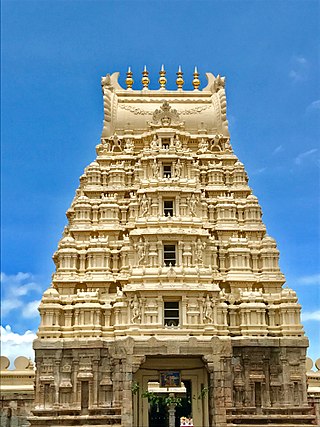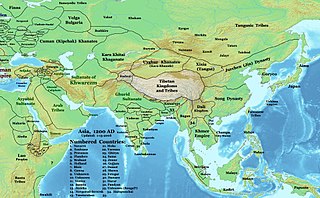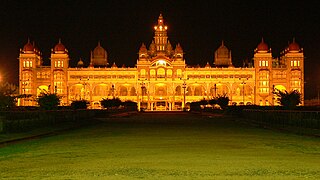
Srirangapatna is a town and headquarters of one of the seven Taluks of Mandya district, in the Indian State of Karnataka. It gets its name from the Ranganthaswamy temple consecrated around AD 984. Later, under the British rule, the city was renamed to Seringapatnam. Located near the city of Mandya, it is of religious, cultural and historic importance.

Kannada literature is the corpus of written forms of the Kannada language, spoken mainly in the Indian state of Karnataka and written in the Kannada script.

The Wadiyar dynasty, also referred to as the Wadiyars of Mysore, is a late-medieval/early-modern South Indian Hindu royal family of former kings of Mysore from the Urs clan originally based in Mysore city.

The Kingdom of Mysore was a realm in the southern part of Deccan Plateau traditionally believed to have been founded in 1399 by two Hindu brothers, in the vicinity of the modern city of Mysore. From 1799 until 1950, it was a princely state, until 1947 in a subsidiary alliance with British India. The British took direct control over the princely state in 1831. Upon accession to the Dominion of India, it became Mysore State, later uniting with other Kannada speaking regions to form the state of Karnataka, with its ruler remaining as Rajapramukh until 1956, when he became the first governor of the reformed state.

Jayachamarajendra Wadiyar, sometimes simply Jayachamaraja Wadiyar, was the twenty-fifth and last ruling Maharaja of Mysore, reigning from 1940 to 1950, who later served as the governor of Mysore until 1964 and as governor of Madras from 1964 to 1966.

Talakadu is a town on the left bank of the Kaveri river 45 km from Mysore and 133 km from Bangalore in Karnataka, India. Latinizations of the towns name vary, but include Talkād, Talakadu, Talakkadu, or Thalakadu. It had over 30 temples, most of which now lay buried in sand. The extant group of temples, where the eastward flowing Kaveri river changes course as the sand on its banks spreads over a wide area, is a popular pilgrimage site for Hindus.

Alagiya Manavalan, best known by his epithet Manavala Mamunigallit. 'The great saint, Manavalan' (1370–1450), was a Hindu theologian. He was a major proponent of the Sri Vaishnavism tradition in the 15th century in Tamilakam, disseminating it with the help of his eight disciples. The disciples of Manavalan established places of learning to teach the Vishishtadvaita philosophy in Tamilakam.

Mysore Vasudevacharya was an Indian musician and composer of Carnatic music compositions who belonged to the direct line of Thyagaraja's disciples. Vasudevachar's compositions were mostly in Telugu and Sanskrit. Some of his most popular kritis include Broche varevaru ra in Khamas raga, Devadideva in Sunadavinodini, Mamavatu Sri Saraswati in Hindolam, Shankari Ninne in Pantuvarali, Bhajare Re Manasa in Abheri and Ra Ra Rajeevalochana Rama in Mohanam. He presided over Madras Music Academy's annual conference in 1935, when the Sangeetha Kalanidhi award did not exist. But everybody who presided over the annual conference in the 1930s was later conferred the award. He was a recipient of the civilian honour of the Padma Bhushan.

Hoysala literature is the large body of literature in the Kannada and Sanskrit languages produced by the Hoysala Empire (1025–1343) in what is now southern India. The empire was established by Nripa Kama II, came into political prominence during the rule of King Vishnuvardhana (1108–1152), and declined gradually after its defeat by the Khalji dynasty invaders in 1311.

Mysore is a city in the state of Karnataka, India. It is known as the cultural capital of Karnataka. Mysore was the capital of the Wodeyar kings who ruled over the Mysore Kingdom for many centuries. Wodeyars were great patrons of art and music and have contributed significantly to make Mysore a cultural centre. Mysore is well known for its palaces, museums and art galleries and the festivities that take place here during the period of Dasara attract a worldwide audience. Mysore has also lent its name to popular dishes like Mysore Masala Dosa and Mysore Pak. Mysore is also the origin of the popular silk sari known as Mysore silk sari and has also given rise to a popular form of painting known as Mysore painting.
Medieval Kannada literature covered a wide range of subjects and genres which can broadly be classified under the Jain, Virashaiva, Vaishnava and secular traditions. These include writings from the 7th century rise of the Badami Chalukya empire to the 16th century, coinciding with the decline of Vijayanagara Empire. The earliest known literary works until about the 12th century CE were mostly authored by the Jainas along with a few works by Virashaivas and Brahmins and hence this period is called the age of Jain literature,. The 13th century CE, to the 15th century CE, saw the emergence of numerous Virashaiva and Brahminical writers with a proportional decline in Jain literary works. Thereafter, Virashaiva and Brahmin writers have dominated the Kannada literary tradition. Some of the earliest metres used by Jain writers prior to 9th century include the chattana, bedande and the melvadu metres, writings in which have not been discovered but are known from references made to them in later centuries. Popular metres from the 9th century onwards when Kannada literature is available are the champu-kavyas or just champu, vachanasangatya, shatpadi, ragale, tripadi, and kavya.

Mysore literature in Kannada is a body of literature composed in the Kannada language in the historical Kingdom of Mysore in Southern India and written in the Kannada script. The writings date from the Kingdom of Mysore, which existed from around 1600 CE until the establishment of modern India in 1947. Many of the works of this literature written on religious themes are labeled Veerashaiva or Vaishnava in acknowledgment of the two faiths that gave form to the literature and fostered it until the advent of the modern era. Despite a gradual decline in the popularity of Jainism, authors devoted to the faith produced some works of merit. Secular themes dealing with a wide range of subjects were also written on. Kannada literature flourished for a short while in the court of the neighbouring kingdom of the Nayakas of Keladi whose territory was annexed by Mysore in 1763.

The Kingdom of Mysore (1399–1950) was founded by Yaduraya in 1399 as a feudatory of the Vijayanagara Empire and became an independent kingdom in the early 17th century, after the decline of the Vijayanagara Empire. Many musicians and composers have presumably adorned the courts of the Mysore kings from Yaduraya's time, furthering the Dakshinadi school of music that had developed in earlier centuries. However, records are only available from the time of King Ranadheera Kanteerava Narasaraja Wodeyar (1638). Musical treatises surviving from this time, though, provide ample information on the music, musical instruments, the types of compositions, the raga (melodies) and the tala (rhythms) used. Though all the Mysore kings patronised music, the golden age of Carnatic music was considered to be during the reigns of Kings Krishnaraja Wodeyar III (1794–1868), Chamaraja Wodeyar IX (1862–1894), Krishnaraja Wodeyar IV (1884–1940) and Jaya Chamaraja Wodeyar (1919–1974). The reign of Krishnaraja Wodeyar IV is regarded as particularly important in musical terms.

The Kingdom of Mysore was a kingdom of southern India founded in 1399 by Yaduraya in the region of the modern city of Mysore. The Wodeyar dynasty, as the ruling family is known, ruled the southern Karnataka region until Indian independence in 1947, when the kingdom was merged with the Union of India.

Vijayanagara literature in Kannada is the body of literature composed in the Kannada language of South India during the ascendancy of the Vijayanagara Empire which lasted from the 14th through the 16th century. The Vijayanagara empire was established in 1336 by Harihara I and his brother Bukka Raya I. Although it lasted until 1664, its power declined after a major military defeat by the Shahi Sultanates in the battle of Talikota in 1565. The empire is named after its capital city Vijayanagara, whose ruins surround modern Hampi, now a World Heritage Site in Karnataka.
Old Kannada or Halegannada is the Kannada language which transformed from Purvada halegannada or Pre-old Kannada during the reign of the Kadambas of Banavasi.

The political history of the region on the Deccan Plateau in west-central peninsular India that was later divided into Mysore state and Coorg province saw many changes after the fall of the Hindu Vijayanagara Empire in 1565. The rise of Sultan Haidar Ali in 1761 introduced a new period.

The name Karnataka is derived from Karunadu, meaning 'lofty land' or 'high plateau', due to its location on the Deccan Plateau. The name can also mean 'land of black soil' in Kannada. There are other possible roots of the name. The recorded history of Karnataka goes back to the Ramayana and Mahabharata epics. The capital of "Baali" and "Sugriva" referenced in the Ramayana is said to be Hampi. Karnataka is mentioned in the Mahabharata as "Karnata Desha"." Historically, the region was also called "Kuntala Rajya".

Singapura is a locality in the northwestern part of Bengaluru, Karnataka, India. The Varadarajaswamy Temple in Singapura is at least 500 years old, as recorded in Harohalli and Chikkabettahalli inscriptions. The temple is referred to as the Tiruvengalanatha temple in inscriptions. The inscriptions also mention a grant given to Ramanuja Koota, a religious institution of Sri Vaishnavites, named after the reformer-saint Ramanuja.















